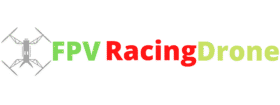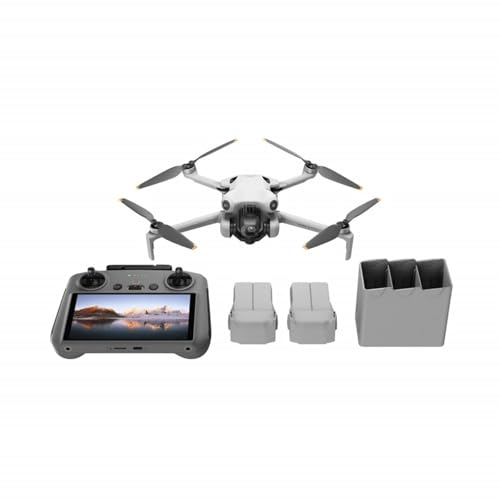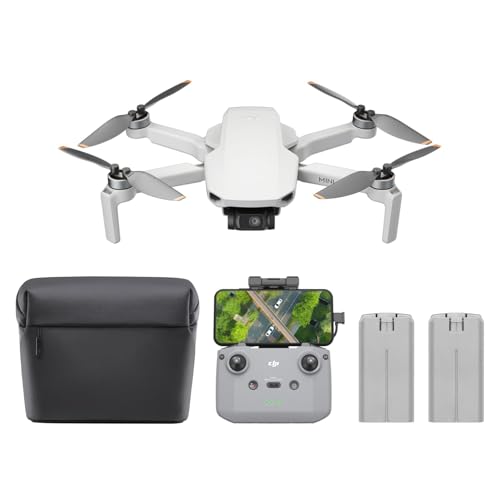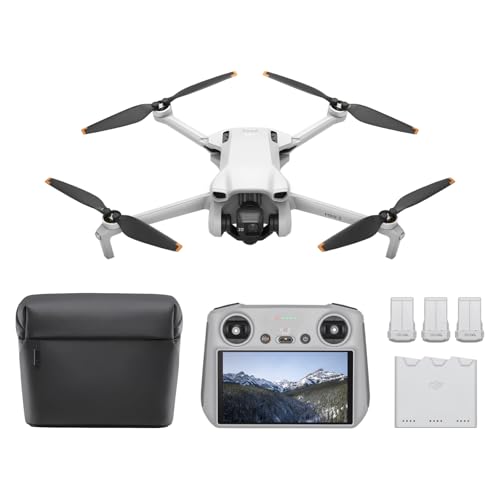Ever dreamed of seeing the world from a bird’s-eye view? Drones have made that dream a reality for hobbyists and photographers alike! But if you’re an adult just dipping your toes into the exciting world of aerial photography and remote-controlled flight, choosing your first drone can feel a bit overwhelming. You’re probably looking for something easy to fly, durable enough to handle a few bumps, and won’t break the bank. You want the best beginner drone for adults that balances performance with user-friendliness.
Don’t sweat it! We’ve done the legwork for you. In this guide, we’ll walk you through seven fantastic options that are perfect for getting started. We’ll highlight what makes each one special, so you can find the perfect entry-level drone to kickstart your aerial adventures.
1. DJI Mini 3 Fly More Combo (DJI RC)

If you’re serious about getting into drone photography and want a fantastic all-rounder right from the start, the DJI Mini 3 Fly More Combo is an exceptional choice. It packs impressive features into a tiny, lightweight package that often doesn’t even require FAA registration, making it incredibly appealing for new pilots. The included DJI RC controller, with its built-in screen, means you don’t even need to use your phone – just grab it and go! Its ability to capture stunning 4K HDR video and perform vertical shooting sets it apart for content creators eager to share on social media.
-
Features:
- Under 249 g: No FAA registration or Remote ID needed for recreational use.
- 4K UHD Stunning Imagery: Film in 4K HDR video with Dual Native ISO Fusion for detailed shots.
- Striking Vertical Videos: True Vertical Shooting for social media-ready content.
- Extended Battery Life: Up to 51 minutes with Intelligent Flight Battery Plus (sold separately), or 114 minutes total with the Fly More combo’s two extra batteries.
- 38kph (Level 5) Wind Resistant: Stable flight with a 3-axis gimbal for smooth 4K footage.
- 10km Max HD Video Transmission: Excellent anti-interference for clear, distant views.
- Creative Features: QuickShots (dynamic flight patterns) and Panorama.
- Beginner-Friendly and Safe: GPS Return to Home (RTH), Precise Hovering, Auto Takeoff/Landing.
- QuickTransfer via Wi-Fi: Fast download speeds to your phone without the remote.
- Includes DJI RC: Controller with pre-installed DJI Fly App and 5.5-inch HD display.
-
Pros:
- Excellent 4K HDR camera quality, especially for its size.
- No FAA registration required for recreational use (under 249g).
- Very long flight time, especially with the Fly More Combo.
- Intuitive DJI RC controller with built-in screen enhances user experience.
- Impressive wind resistance for stable shots.
- Advanced safety features like RTH make it ideal for beginners.
-
Cons:
- Higher price point compared to other beginner options.
- Intelligent Flight Battery Plus makes the drone exceed 249g.
- Some features might take a little learning for absolute novices.
-
User Impressions: Users consistently praise the Mini 3 for its fantastic camera quality and how easy it is to fly, even for complete novices. The DJI RC is a game-changer for many, simplifying the setup process. While it’s a bit of a splurge, customers feel the performance and features justify the investment, making it a strong contender for the best beginner drone for adults looking for quality.
2. Drone with Camera 1080P HD FPV Foldable Drone

Looking for a truly accessible and fun introduction to drones without a hefty price tag? This 1080P HD FPV Foldable Drone is designed with the absolute beginner in mind. It’s packed with user-friendly features that make learning to fly a breeze, perfect for both kids and adults taking their first steps. Plus, its foldable design and included carrying bag mean you can take your aerial adventures anywhere.
-
Features:
- 1080P HD Camera: Adjustable angle for capturing photos and videos, with FPV real-time video feed via “Velcase VGO” app.
- Multiple Functions for Kids/Beginners: Optical flow positioning, altitude hold, 3D flips, headless mode, three-speed modes, one-key takeoff/landing/return/emergency stop, trajectory flight, gesture photo/video, voice control, low battery warning.
- Foldable Drone: Portable design with included bag.
- Extended Flight Time: Two 1050mAh batteries provide up to 26 minutes total flight time.
- Full Accessories: Includes remote control batteries, propeller guards, and spare fan blades.
- One Key Take-off & Optical Flow Positioning: Ensures stable and easy flight.
- Professional Flight Partner: 24-hour technical support and refund services.
-
Pros:
- Extremely beginner-friendly with numerous assist features.
- Affordable entry point into drone flying.
- Portable and easy to carry with the foldable design and included bag.
- Good flight time for its category with two batteries.
- Fun features like 3D flips and gesture control add to the enjoyment.
-
Cons:
- 1080P camera is decent but won’t match 4K clarity.
- Flight performance might be less stable in windy conditions compared to higher-end models.
- App experience may not be as polished as premium brands.
-
User Impressions: Customers love how easy this drone is to get off the ground and fly, especially for those new to the hobby. The multiple beginner-friendly functions and the dual battery setup are frequently highlighted as major positives. It’s seen as a great value option for casual fun and learning.
3. Drone with Camera, 2K HD FPV Drones with GPS Auto

This 2K HD FPV Drone with GPS Auto is a fantastic mid-range option for beginners who want more advanced features without stepping into the premium price bracket. The inclusion of GPS positioning offers intelligent flight modes and enhanced safety, making it a reassuring choice for new pilots. Its brushless motors provide superior performance and wind resistance, ensuring a more stable and enjoyable flying experience.
-
Features:
- 2K HD Camera & 5G Real-Time Transmission: Crisp 2K photos/videos with smooth 5G Wi-Fi FPV. 90° electric adjustable camera with 110° wide-angle lens.
- Advanced GPS Drone Flight System: Precision Auto Return-to-Home (RTH), Smart Tracking (Follow Me, Circle Fly, Waypoints Fly), Last-known GPS location, flight path recording.
- Brushless Motor for Superior Performance: High-efficiency motors (20,000-hour lifespan) provide powerful thrust and Level 5 wind resistance.
- Extended Battery Life: Two rechargeable batteries offer up to 32 minutes of total flight time.
- Foldable Drone, Portable, No FAA: Lightweight (under 249g) for easy transport, no FAA registration or Remote ID needed. Comes with carrying bag, propeller guards, and spare blades.
- Helpful Calibration Tips: Clear instructions for compass and gyro calibration.
-
Pros:
- 2K camera offers a good balance of quality and price.
- Robust GPS features significantly enhance safety and ease of use for beginners.
- Brushless motors provide improved durability, power, and wind resistance.
- Excellent total flight time with two included batteries.
- Lightweight design (under 249g) avoids FAA registration requirements.
-
Cons:
- Learning GPS functions might require a slightly steeper learning curve for absolute first-timers.
- 5G Wi-Fi transmission requires a compatible phone.
- Battery charging time may vary.
-
User Impressions: Many users praise its stable flight thanks to the GPS and brushless motors. The 2K camera is generally well-received for capturing solid aerial footage. The convenience of not needing FAA registration and the inclusion of intelligent flight modes make it a highly recommended choice for a beginner adult drone pilot wanting more advanced capabilities.
4. X-shop 4K GPS Drone with Camera for Adults, Brushless
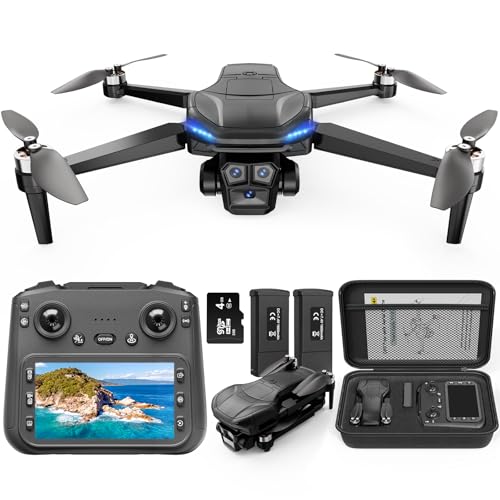
For those who prioritize ease of use and a high-quality viewing experience right out of the box, the X-shop 4K GPS Drone stands out with its innovative remote control featuring a built-in HD screen. This eliminates the need for a smartphone, streamlining your flying process. Coupled with a 4K camera and impressive flight time, it’s a solid contender for the best beginner drone for adults seeking simplicity and performance.
-
Features:
- 4K Drone with Screen Remote: Built-in 4.5-inch HD screen on the remote for live footage, photos, and videos, saved instantly to an included SD card.
- GPS Intelligent Positioning: GPS and optical flow positioning for stable flight. Auto Return-to-Home (low battery/signal loss). Intelligent flight modes (Auto-Follow, Waypoint Navigation, Point of Interest) via smartphone APP.
- Brushless Motor: High-performance brushless motor with Level 6 wind resistance for stable operation.
- 60-Min Max Flight Time: Two 1600 mAh batteries provide up to 60 minutes total flight time.
- All-in-one Beginner Device: One-key takeoff/landing, headless mode, 3-speed control, GPS auto return.
- Foldable Design: Under 249g, requires no FAA registration for recreational use.
-
Pros:
- Integrated screen remote control is highly convenient and user-friendly.
- Excellent 4K camera for sharp aerial captures.
- Very long total flight time with two batteries, reducing downtime.
- Robust GPS features for safe and intelligent flights.
- Brushless motors provide superior stability and wind resistance.
- No FAA registration required due to lightweight design.
-
Cons:
- Advanced intelligent flight modes still require a smartphone app.
- The integrated screen might be smaller than a typical smartphone display.
- May be slightly less compact than other under-249g drones due to the remote’s screen.
-
User Impressions: Reviewers frequently highlight the built-in screen on the remote as a major convenience, making the drone very quick and easy to get flying. The long flight time is also a huge hit, allowing for extended exploration and filming. It’s often recommended for beginners who want a more streamlined flying experience without fiddling with their phone.
5. PLEGBLE Drones with Camera for Adults 4K Brushless Motor

The PLEGBLE PL515 is designed for adults who want a high-quality camera and a stable flying experience right from the start. Its 4K UHD camera with image stabilization ensures your footage looks professional, even if you’re a novice. Combine that with efficient brushless motors and enhanced safety features like a child lock, and you have a drone that’s both powerful and reassuring for beginners.
-
Features:
- Ultimate Fusion: 4K HD Camera, Image Stabilization, and FPV: Sharper visuals, faster bit rates, optimized camera modules, shock-absorbing mount, ultra-smooth FPV, adjustable 90° lens.
- Brushless Drones: Stability, Efficiency, Wind Resistance: Longer lifespan, lower power consumption, higher flight speeds, altitude maintenance, ground detection technology for enhanced wind resistance.
- Dual-Battery Upgrade: Longer Flight, More Portable: Two enhanced batteries for 32 minutes total flight time. USB 3.0 charging (USB-C/PD compatible, UL-certified). Foldable design with dedicated storage box.
- Smart Child Lock: Safe Takeoff: Prevents accidental operations. Equipped with propeller guards.
- Ultra-lightweight, No FAA or Remote ID Registration Required: Under 250 grams.
- Comprehensive support: Video tutorials, instructions, and customer support.
-
Pros:
- Image stabilization for the 4K camera is a significant advantage for clear footage.
- Brushless motors provide excellent stability, efficiency, and wind resistance.
- Dual batteries extend flight time to a respectable 32 minutes.
- Child lock and propeller guards enhance safety, especially for new users.
- Lightweight design means no FAA registration is required.
- Good support resources available.
-
Cons:
- Specific GPS features like Follow Me or Waypoints are not explicitly mentioned in the features.
- The “child lock” naming might be slightly confusing for an adult-focused drone.
- Performance in very strong winds might still be challenging for any lightweight drone.
-
User Impressions: Users are impressed by the smooth, stable footage achieved with the image-stabilized 4K camera. The durability and efficiency of the brushless motors also receive high marks, making it feel like a more premium drone for its price. Many appreciate the thoughtful safety features, making it a worry-free choice for their first serious quadcopter.
6. DJI Mini 4K, Drone with 4K UHD Camera for Adults

If you’ve always wanted a DJI drone but were looking for a more budget-friendly entry point, the DJI Mini 4K is your answer. It distills the core DJI experience – stable flight, good camera, and user-friendly controls – into an incredibly accessible package. This makes it an outstanding candidate for the best beginner drone for adults who value brand reputation and reliability without the premium price tag of more advanced models.
-
Features:
- No Registration Needed: Under 249 g, no FAA registration or Remote ID for recreational use.
- 4K Ultra HD & 3-Axis Gimbal: Cinematic quality shooting in 4K resolution with stable 3-axis gimbal.
- 38kph (Level 5) Wind Resistant: Stable flight even in Level 5 winds with brushless motors.
- Uninterrupted Creation with Extended Battery Life: Choose from 1-battery (31-min), 2-battery (62-min), or 3-battery (93-min) sets.
- Beginner-Friendly and Safe: One-tap takeoff/landing, GPS Return to Home (RTH), stable hovering, easy operation.
- Boost Your Inspiration with Intelligent QuickShots: Automatic professional-level videos (Helix, Dronie, Rocket, Circle, Boomerang).
- Includes DJI Mini 4K, 1 battery, an RC-N1C, and everything needed for easy 4K flights.
-
Pros:
- Access to DJI’s renowned flight stability and reliability at an affordable price.
- Excellent 4K camera with a 3-axis gimbal for truly cinematic footage.
- Lightweight design avoids FAA registration for recreational users.
- Impressive wind resistance for a drone of its size.
- Very beginner-friendly with GPS RTH and QuickShots.
- Flexible battery options for desired flight duration.
-
Cons:
- The DJI Fly app needs to be downloaded directly from the DJI website for Android users (not on Google Play).
- The base package only includes one battery, limiting flight time to 31 minutes.
- Lacks some of the more advanced features of higher-end DJI Mini models.
-
User Impressions: Many beginners express immense satisfaction with the DJI Mini 4K, often citing its ease of flight and the surprisingly good 4K camera as highlights. The “no registration” aspect is a big draw, and people appreciate the solid, reliable performance that DJI is known for, making it a fantastic entry-level camera drone.
7. Drone with Camera, Drones for Adults and Beginners, 1080P
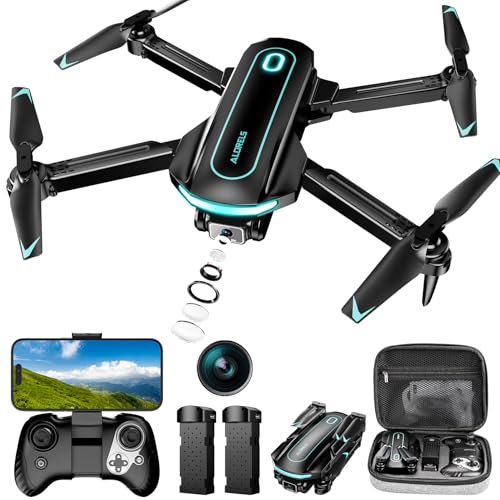
If you’re looking for an incredibly simple and fun drone to learn the ropes with, this 1080P camera drone is a fantastic choice for both adults and younger pilots. It focuses on core beginner-friendly features, ensuring your first flights are enjoyable and stress-free. With its compact, foldable design and intuitive controls, it’s a perfect gift or a low-commitment way to explore the world of drones.
-
Features:
- FPV Drone with 1080P Camera: Tiltable camera (app, remote, or manual control) with optical flow positioning for stable hover and real-time HD transmission.
- Extended Flight Time: Two rechargeable batteries provide up to 24–28 minutes total flight.
- Beginner-Friendly: Over-current protection, emergency stop, trajectory flight, gravity control, 3D flip, headless mode, 3-speed mode, one-key takeoff/landing, gesture photo.
- Helpful Tips: Clear instructions for gyroscope calibration.
- Remote & App Control: Connect via “JY016FPV_XXXXXX” WiFi and “JY016 DRONE” app.
-
Pros:
- Extremely easy to fly with features like one-key takeoff/landing and headless mode.
- Optical flow positioning helps maintain a stable hover indoors or with good ground features.
- Good total flight time with two included batteries.
- Fun features like 3D flips and gravity control add to the learning experience.
- Foldable and portable, making it easy to carry.
- Very budget-friendly.
-
Cons:
- 1080P camera resolution is adequate but not 4K.
- Lacks GPS for outdoor precision and advanced safety features like RTH.
- Flight performance can be more susceptible to wind.
- App interface might be basic compared to higher-end models.
-
User Impressions: Users frequently commend this drone for its sheer simplicity and affordability. It’s often highlighted as an excellent learning tool due to its forgiving controls and robust safety features. The dual batteries are a big plus, allowing extended playtime, and many find it a great choice for casual indoor and outdoor flying.
Frequently Asked Questions (FAQ) about Beginner Drones for Adults
Q1: What makes a drone “beginner-friendly” for adults?
A1: A beginner-friendly drone typically features easy-to-use controls, one-key takeoff/landing, headless mode (which simplifies orientation), altitude hold for stable hovering, and robust safety features like propeller guards and emergency stop. Many also include GPS for better stability and automatic return-to-home functions.
Q2: Do I need to register my drone with the FAA?
A2: In the United States, if your drone weighs less than 249 grams and you’re flying purely for recreational purposes, you generally don’t need to register it with the FAA. However, if your drone weighs 250 grams or more, or if you’re flying for commercial purposes, registration is required. Always check the latest local regulations as rules can change.
Q3: How important is camera quality for my first drone?
A3: It depends on your primary goal. If you mostly want to learn to fly and have fun, a 720p or 1080p camera is perfectly adequate. If you’re keen on capturing high-quality aerial photos and videos for social media or personal projects, then a 2K or 4K camera with image stabilization would be a better investment, offering clearer and more professional-looking footage.
Q4: What’s a good flight time for a beginner drone, and should I get extra batteries?
A4: For most beginner drones, a single battery typically offers 10-15 minutes of flight time. Drones with 20+ minutes per battery are considered good. We highly recommend getting extra batteries, or a “Fly More” combo, as it significantly extends your fun and learning time without constant recharging breaks.
Q5: What is “headless mode” and why is it helpful for beginners?
A5: Headless mode simplifies drone control by ignoring the drone’s actual orientation. Instead, it always moves forward, backward, left, or right relative to the pilot, regardless of which way the drone’s “head” (front) is pointing. This eliminates confusion and makes it much easier for new pilots to learn basic flight movements.
Q6: Are propeller guards necessary for beginner drones?
A6: Absolutely! Propeller guards are highly recommended for beginners. They protect the propellers from damage during bumps and crashes, and more importantly, they protect people and objects from spinning blades. They’re a small addition that can save you from frustration and potential injury.
Q7: How much should I expect to pay for the best beginner drone for adults?
A7: The price range for a quality beginner drone can vary widely, from around $50-$100 for very basic models with 1080p cameras and essential features, up to $300-$500+ for premium entry-level drones like the DJI Mini series, which offer 4K cameras, GPS, and advanced stability. Your ideal budget depends on the features you prioritize.
Ready for Takeoff?
Choosing the best beginner drone for adults doesn’t have to be a daunting task. Whether you’re aiming for cinematic 4K shots or just want a fun, easy-to-fly gadget to explore the skies, there’s a perfect drone out there for you.
Consider what’s most important to you: camera quality, flight time, ease of use, or perhaps a balance of all three within your budget. Any of the drones on this list will provide a fantastic starting point for your aerial adventures. So, pick your favorite, charge those batteries, and get ready to see the world from a whole new perspective! Happy flying!
